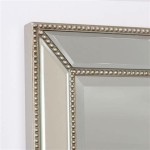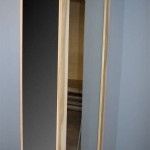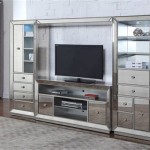What a Convex Mirror Does to an Image
Convex mirrors, also known as diverging mirrors, are curved mirrors where the reflective surface bulges outwards. This curvature dictates the manner in which light rays interact with the mirror, ultimately shaping the characteristics of the images they form. Understanding the behavior of convex mirrors requires an examination of their optical properties, including focal length, image location, size, and orientation. The impact of a convex mirror differs significantly from that of a concave mirror due to its distinct geometry.
The primary function of a convex mirror is to spread out the light that strikes its surface. Parallel light rays incident on a convex mirror diverge after reflection. This divergence is responsible for the formation of images that are always virtual, upright, and smaller than the actual object. The extent to which the image is reduced in size depends on the curvature of the mirror and the distance of the object from the mirror’s surface. These factors determine the precise image characteristics formed by the mirror.
Image Formation and Characteristics
The image formation process in a convex mirror can be understood by tracing the path of light rays. Consider an object placed in front of the mirror. Two principal rays are typically used to locate the image. The first ray travels parallel to the principal axis and, upon reflection, appears to originate from the focal point behind the mirror. The second ray is directed towards the center of curvature behind the mirror. Upon reflection, this ray retraces its path back along the same line. The point where these two reflected rays appear to intersect (behind the mirror) determines the location of the virtual image.
Given the ray tracing principles described above, the image formed by a convex mirror always possesses three key characteristics: virtual, upright, and diminished. The term "virtual" signifies that the image is not formed by the actual intersection of light rays; instead, it is formed by the apparent intersection of extrapolated rays behind the mirror. As a result, the image cannot be projected onto a screen. The "upright" characteristic implies that the image has the same orientation as the object. If the object is vertically oriented, the image will also be vertically oriented, not inverted. Lastly, the term "diminished" indicates that the image is smaller than the actual object. The degree of reduction in size is related to the object's distance from the mirror and the mirror's radius of curvature.
The mirror equation and magnification equation quantify the relationship between object distance (u), image distance (v), focal length (f), object height (ho), and image height (hi). The mirror equation is expressed as 1/f = 1/u + 1/v. For convex mirrors, the focal length (f) is always negative, indicating that the focal point is located behind the mirror. The image distance (v) is also negative, confirming that the image is virtual and formed behind the mirror. The magnification equation is given by m = hi/ho = -v/u. Since the image distance (v) is negative and the object distance (u) is positive, the magnification (m) is a positive value less than 1, signifying an upright and diminished image.
An example will further illustrate how these equations apply. Imagine an upright object 1 meter tall is placed 2 meters in front of a convex mirror with a focal length of -1 meter. Using the mirror equation: 1/(-1) = 1/2 + 1/v. Solving for v, we get v = -2/3 meters. Notice the value of v is negative. Using the magnification equation: m = -(-2/3)/2 = 1/3. The value is positive, but less than one. The image is 1/3 the size of the object, and is upright.
Wider Field of View
One of the most significant advantages of convex mirrors is their ability to provide a wider field of view compared to plane mirrors or concave mirrors. This wider field of view arises from the diverging nature of the reflected light rays. Because the light is spread out, the observer can see a larger area reflected in the mirror than would be possible with a flat or converging surface.
The wider field of view makes convex mirrors particularly useful in situations where situational awareness is crucial. For example, they are commonly used as rearview mirrors in vehicles to provide drivers with a broader view of traffic behind them, reducing blind spots. In retail environments, convex mirrors, often referred to as security mirrors, are strategically placed to monitor large areas for theft or suspicious activity. The wide field of view allows security personnel to observe a significantly larger portion of the store compared to using traditional flat mirrors or direct observation alone.
Furthermore, convex mirrors are frequently employed in industrial settings to improve safety and efficiency. They can be positioned at intersections in warehouses or factories to help prevent collisions between forklifts and other vehicles. The expanded view allows operators to see oncoming traffic from multiple directions, enhancing overall safety. In tight or confined spaces, such as parking garages, convex mirrors provide drivers with a better view of their surroundings, facilitating easier maneuvering and reducing the risk of accidents. The practical applications stemming from the wider field of view are extensive across different industries.
The curvature affects the field of view. A more pronounced curve in the mirror yields a wider field of view, but at the expense of a greater degree of image distortion. Conversely, a flatter convex mirror offers a narrower field of view but with less distortion. The optimal curvature is chosen based on the specific application, balancing the need for a wide view with acceptable image clarity.
Applications Based on Image Characteristics
The unique image characteristics of convex mirrors, namely their virtual, upright, and diminished nature, combined with their wide field of view, make them suitable for a variety of specific applications. Each application leverages one or more of these characteristics to achieve a particular objective.
As previously noted, rearview mirrors in vehicles are a prime example. The diminished image allows drivers to see a larger area of traffic behind them, while the upright orientation ensures that the objects appear in their correct orientation. Although the distances perceived in convex mirrors are not perfectly accurate due to the image distortion, drivers quickly learn to compensate for this distortion and judge distances effectively. The wider field of view is more important than perfectly accurate distance perception, especially when compared to the limited field of view offered by flat mirrors.
Another crucial application is in security systems. Convex mirrors are often used in hallways, blind corners, and retail stores to provide a wide-angle view of the surroundings. This allows security personnel to monitor a larger area and detect potential security breaches or accidents. The diminished image allows for a greater area to be seen within a single mirror, while the upright orientation ensures that objects and people appear as they should, simplifying identification and response. Their presence can act as a deterrent to potential shoplifters and can help prevent accidents in high-traffic areas.
Moreover, convex mirrors are widely employed in ATMs and computer monitors. The mirrors offer a wide angle view so that the customers using the ATM are aware of their surroundings and others who may be loitering nearby. For computer monitors, the mirrors are often placed at the top of the screen so that employees are aware of their surroundings. Another application is in dentistry. Dental mirrors are sometimes convex to provide a wider view of the oral cavity during examinations and procedures. The wider field of view helps dentists visualize difficult-to-reach areas and enhances the precision of their work.
Ultimately, the range of applications for convex mirrors is broad and varied, driven by their ability to provide a wider field of view and create manageable images. Understanding the underlying principles of how convex mirrors alter images allows for proper implementation and effective utilization in numerous fields.

Convex Mirror Science Learning Hub

Convex Mirror Uses Of Definition Equation

Convex Mirror Uses Of Definition Equation

Convex Mirror Image Formation Conditions Ray Diagram Uses

Convex Mirror Image Formation Conditions Ray Diagram Uses

Concave Mirrors And Convex Image Formation Ray Diagram
What Does It Mean When A Virtual Image Is Formed Behind Convex Mirror Possible Quora

Convex Mirror S

Convex Mirror Study Guide Inspirit Learning Inc

Concave Mirror Science Learning Hub








